
Some nice things
 |
Some nice things |
Officine Panerai was born in a small workshop in Florence specializing in high precision work and sophisticated mechanical devices. It was in 1936, as a result of the technology acquired in these fields, that Officine Panerai created the first prototype of a new design of underwater watch, intended for use by a special, secret military force which was being formed in Italy. In 1938 Radiomir Panerai watches entered permanent regular service with the Royal Italian Navy. In the 1950s the Radiomir Panerai was first joined and then replaced by the Panerai Luminor, a model which reserved the case design and dial of the original historic watch, but incorporated significant improvements. The watch's water-resistance was perfected by the adoption of a special lever device, which kept the winding crown pressed against the case. Over the years, this unique arrangement has become a distinctive mark of Panerai and it has been registered as a trade mark. The movement mainly used was an Angelus calibre with 8-day winding reserve, which allowed the winding crown to be used less frequently, thus reducing the risk of water penetration round the crown. |
| In
1993 and again in 1997, two re-editions of the Panerai
Luminor were produced, making them available to the
public for the first time. Water-resistance is guaranteed
to 300 metres, but during testing every example is
actually submitted to a pressure equivalent to a depth of
400 metres. Panerai watches are unique and unmistakable
through their design, the large size of the watch being
perfectly balanced by the minimalist graphics of the dial.
The requirement of making the time immediately readable
under conditions of little or no light has led to the
creation of a dial of clear and essential style, with
distinctive luminous hands and markings. Click on either watch to go to different Panerai information sites! |
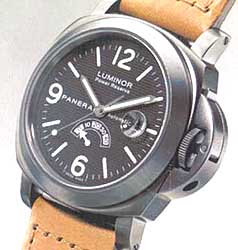 |
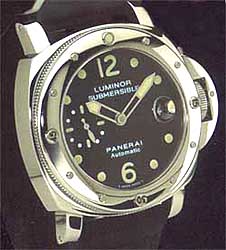 |
| GIRARD-PERREGAUX,
the second oldest Swiss
watch manufacturer, is based in La Chaux-de-Fonds. In 1880,
Constant Girard designed and produced the very first
production wristwatch, intended for officers in the
German navy. J.-F. Bautte founded Girard-Perregaux in
1791 and produced ultra-thin watches. In 1966 Girard-Perregaux
produced the first high-frequency mechanical watch, and
in 1969 the first mass-produced quartz watch. While I have always been a traditionalist at heart, I am greatly attracted to anything high-tech, including exotic materials. It is difficult to top the GIRARD-PERREGAUX Ferrari on the right in this respect: it features a stainless steel case, a black carbon fiber dial, and a black kevlar strap with ardilion buckle. It has an automatic movement with calendar display beside the chronograph functions. Pour Ferrari F50, an automatic chronograph with perpetual calendar, only available in gold or platinum, comes in what must be the most elaborate display case, which somehow reminds me of a cash register more than anything else. On the left, a closer view of the F50. |
 |
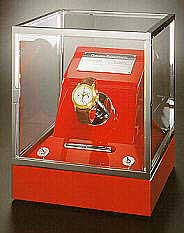 |
 |
 …is
another watch company I originally intended to include
among the less-known brands, but first ran out of space
on the page, then realized that among watch people,
Minerva is not only well-known, but also highly respected
for the quality of their products. Minerva Watches began
their history in 1858 in Villeret, Switzerland, where
they continue to manufacture a variety of handcrafted
watches to this day. Unfortunately, and curiously in tune
with the rather Spartan appearance of their timepieces,
the Minerva site offers very little information on the
history and evolution of the brand. More can be learned
on the TimeZone Minerva forum, which also includes an
exposé by Phil Baker about his visit to the Minerva
workshops. Rather than repeating excerpts from his
account, here is a link: Phil
Baker's visit to Minerva. …is
another watch company I originally intended to include
among the less-known brands, but first ran out of space
on the page, then realized that among watch people,
Minerva is not only well-known, but also highly respected
for the quality of their products. Minerva Watches began
their history in 1858 in Villeret, Switzerland, where
they continue to manufacture a variety of handcrafted
watches to this day. Unfortunately, and curiously in tune
with the rather Spartan appearance of their timepieces,
the Minerva site offers very little information on the
history and evolution of the brand. More can be learned
on the TimeZone Minerva forum, which also includes an
exposé by Phil Baker about his visit to the Minerva
workshops. Rather than repeating excerpts from his
account, here is a link: Phil
Baker's visit to Minerva. |
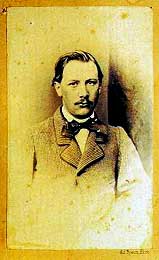 |
| To the right is a photograph of a rather stern looking Charles-Yvan Robert, the co-founder of Minerva, dating from 1862. He was only 22 years old at the time but had already been involved in watchmaking for four years. |
|
||||||||
Above
are four examples of Minerva's history, a model from 1942,
followed by one from 1945 and another from 1954, and on
the extreme right the recent anniversary issue. The
watches clearly demonstrate that once you find a good
thing, there is no need to change it drastically. I guess
the same argument is regularly raised by defenders of Rolex
when that company's lack of innovative designs is
criticised.
|
||||||||
| Probably the most bizarre watch to appear in the past few years is the HALTER BARNES Time Machine Perpetual Antiqua, below on the left. This perpetual date calendar watch features four dials indicating the hours, minutes, day, date and month. |
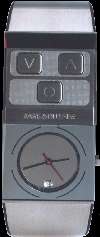 |
The only thing more unusual then the Halter Barnes I can think of coming across on my travels on the Internet is the Beowatch by Bang & Olufsen, here in the only picture (not a good one) I could ever find of it. I would love to find out something about this gadget - does it also work as a remote control, phone or portable radio, where can you find one, how much is it, ... but I have found no such information. It certainly looks like a must-have for any devotee of high-tech design in general and Bang & Olufsen fans specifically. |
| Page 1: hello |
Page 2: nice things |
Page 3: Audemars Piguet |
Page 4: IWC, JLC |
Page 5: Patek Philippe |
| Page 6: Flieger |
Page 7: more Flieger |
Page 8: Zenith, Eberhard |
Page 9: chronographs |
Page 10: big money! |
| Page 11: mo' money |
Page 12:
more chronos |
Page 13: less known gems |
Page 14: moonstruck |
Page 15: pictures & links |